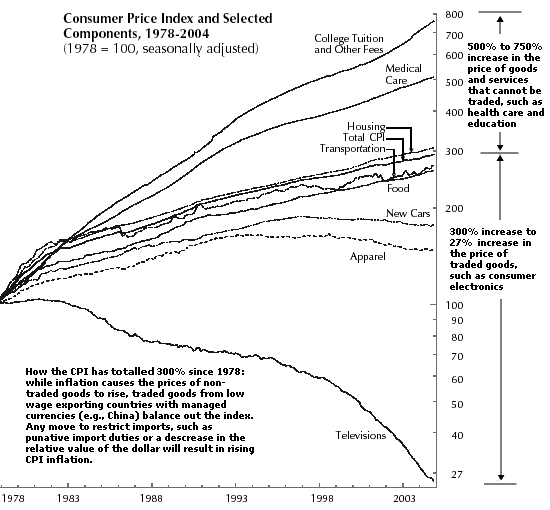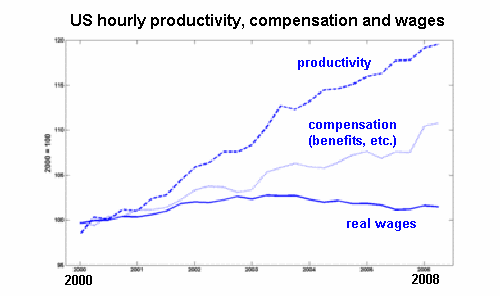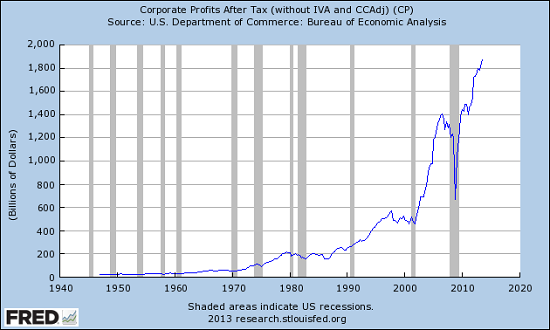Skip to comments.
How the Middle Class Lifestyle Became Unaffordable
Of Two Minds ^
| 05/08/2014
| CHARLES HUGH SMITH
Posted on 05/08/2014 7:10:27 AM PDT by SeekAndFind
There are four structural drivers behind the soaring costs of the middle class lifestyle.
Why have the costs of a middle class lifestyle soared while income has stagnated?Though it is tempting to finger one ideologically convenient cause or another, there are four structural causes to this long-term trend:
1. Baumol's Cost Disease
2. Systemic headwinds to the current version of capitalism
3. Dominance of global corporate capital
4. Financialization
The key take-away here is that the first two causes are structural and cannot be changed by passing a law or funding another state bureaucracy. Though many believe they can tax global corporate capital to eliminate wealth inequality, capital is mobile and will move to where it can expand. The dominance of money in politics also means that the political machinery is for sale to the highest bidder, which just so happens to be global capital.
Since financialization rewards both capital and the central state that depends on tax revenue, reversing financialization politically is a non-starter.
No wonder the middle class is evaporating. These trends are far more powerful than the proposed solutions.
Let's start with Baumol's cost disease, named after economist William J. Baumol, whose work with William G. Bowen I described in Productivity, Baumol's Disease and the Cliff Just Ahead (December 8, 2010).
Baumol examined the relationship between productivity and cost, and found that productivity in labor-intensive services (for example, nursing and teaching) had intrinsically lower rates of productivity increases than goods-producing industries.
The performing arts offers a striking example: it takes the same time to learn and play a Mozart concerto now as it did in 1790, so productivity gains will be modest.
This can be clearly seen in this chart of the consumer price index, 1977-2005:

Note how manufactured goods such as TVs, clothing and autos fell in price while education and healthcare soared. Baumol foresaw the crunch that his theory predicted: as healthcare and education took a larger share of the national income/GDP, taxes would have to rise substantially to pay for those services.
He described the social choices we faced in a seminal 1993 paper: Health care, education and the cost disease: A looming crisis for public choice.
Baumol under-estimated the power of the low-productivity sectors such as healthcare and higher education to exploit political capture to increase their share of the national income. In other words, the extraordinary rise in healthcare and higher education costs arise not just from the low productivity of these sectors, but from their cartel power to obscure the true costs of their bloat and push prices higher.
Baumol also failed to appreciate how the state (government) is the willing partner in this exploitation of low productivity. The state enforces the monopoly pricing power of these cartels. As a result, potential gains in productivity from technology are suppressed to protect the cartels from any real competition. (The same can be said of the military-industrial complex and other state-protected cartels.)
That's how we end up with college degrees and medical procedures that cost more than a house.
The second set of systemic cost drivers were identified by Immanuel Wallerstein, who views these forces as threats to capitalism's prime directive, which is to accumulate more capital:
1. Urbanization, which increases the cost of labor
2. Externalized costs (dumping private waste into the Commons, environmental damage and depletion, etc.) are finally having to be paid
3. Rising taxes as the Central State responds to unlimited demands by citizens for more services (education, healthcare, etc.) and economic security (pensions, welfare)
I covered these headwinds to capitalism in Is This the Terminal Phase of Global Capitalism 1.0? (February 8, 2013).
In brief, urbanization drives wages higher, regardless of the era or economic system, and external costs such as pollution and depletion must eventually be paid out of labor and capital alike. The demand for more state services is unquenchable, and the state responds by buying off key constituencies with more benefits.
Wallerstein is one of the few who clearly understands the State's role as enabler and enforcer of monopolies and cartels. High profit margins are most easily maintained by persuading politicians to create/regulate quasi-monopolies and cartels.
The State has two core mandates: enforce quasi-monopolies and cartels for private capital, and satisfy enough of the citizenry's demands for more benefits to maintain social stability.
If the State fails to maintain monopolistic cartels, profit margins plummet and capital is unable to maintain its spending on investment and labor. Simply put, the economy tanks as profits, investment and growth all stagnate.
If the State fails to satisfy enough of the citizenry's demands, it risks social instability.
That is the nation-state's quandary everywhere. With growth slowing and parasitic cartels increasingly difficult to maintain and justify, the State has less tax income to fund its ever-expanding social spending.
In response, the State raises taxes and borrows the difference between its spending and its revenues. This further squeezes spending as the cost of servicing debt rises along with the debt. The rising cost of debt service is an ever-tightening noose that cannot be escaped.
Here are two charts: the first is productivity, the second is corporate profits. Note that while wages have stagnated, the cost of benefits (healthcare and pensions) has absorbed much of the increase in productivity. The rest has gone to corporate profits:


And this leads us straight to financialization, the parasitic extraction of profits from the real economy by finance and the state. Remember Wallerstein's key insight: the state depends on cartel pricing to sustain high labor costs, investment and the taxes that flow from high wages and profits. As the real economy stagnated, the state (which includes the Federal Reserve) incentivized financialization and speculative credit bubbles to keep the money flowing to feed its own spending.
In other words, the state isn't just a passive patsy in financialization--it is a willing partner, because financialization funds the state. Just look at the enormous expansion of property taxes and income taxes that flowed from the housing and stock market bubbles.
Asking the state to limit financialization is like asking the fox guarding the henhouse to stop eating plump hens. If the fox stops consuming the plump hens, it dies. If the state stops financialization, the state's enormously expensive programs and its debt machine all die, too.
In essence, the state has no choice: to save itself, the middle class must be sacrificed. From the point of view of global capital, the ideal partner is a powerful central state that imposes cartel pricing on the economy: $200 million a piece F-35 fighter jets, $100,000 college diplomas, $200,000 medical procedures, $1,000 a pill medications, etc.
From the point of view of the state, it's more important to protect corporate profits and preserve the ability to borrow another trillion dollars at near-zero interest rates than it is to restore a vibrant middle class.
Debt-serfdom works just fine for the financial sector and the central state that enforces the serfdom. Food stamps (bread) and distracting entertainment (circuses) are cheap. What's not to like about debt-serfdom to those in power? Not only is it an ideal arrangement, it's the only one left to the state and its partner, global capital.
TOPICS: Business/Economy; Society
KEYWORDS: affordability; livingexpenses; middleclass
To: SeekAndFind
How the Middle Class Lifestyle Became UnaffordableOne word: democRATS
2
posted on
05/08/2014 7:19:03 AM PDT
by
Puppage
(You may disagree with what I have to say, but I shall defend to your death my right to say it)
To: SeekAndFind
Great article, SAF. Thanks for posting. It does a great job of describing the economic theory behind the enormous growth of government and loss of the middle class.
To: SeekAndFind
It has long been the goal of international Marxists to destroy the middle class who they blame for preventing their glorious revolution of the proletariat.
To: SeekAndFind
The “middle class” lifestyle began to become unaffordable due to three things: women entering the workforce en masse, drivng down future wage gains for all; the expectation that every high schooler must attend college to succeed, supported by subsidy and debt, driving up the cost of college education; and trade policy collapsing entire segments of the US economy, which reduced wage stability and the opportunity for future advancement.
The end result was families in which both husband and wife absolutely had to work at increasingly less desirable jobs in order to maintain even a semblance of the lifestyle of the previous generation, which was in most instances supported on one income.
To: Puppage
Chrony-capitalist/socialist-fascism.
It’s really a multifaceted type of corruption.
6
posted on
05/08/2014 7:33:46 AM PDT
by
Blue Collar Christian
(Vote Democrat. Once you're OK with killing babies the rest is easy. <BCC><)
To: RegulatorCountry
so true....my dad was a Teamster and my mom stayed at home. we lived ok. today my wife and i are both college educated and fairly successful in our trades and based on the bureau of labor and statistics tables for CPI we make about 20% less than my father did all by himself back in 1980
To: SeekAndFind
The bit about "financialization" is very powerful. Through financialization the "economy" has diverted all the gains in productivity to a small number of people in the "financial" industry. These financially folks (e.g., "hedge fund operators") are easily -- and willingly -- taxed to support the unending growth of government. Besides taxes, these financial winners make huge political donations to support the uniparty and keep the game going.
No wonder the Tea Party is seen as the real enemy.
8
posted on
05/08/2014 7:51:51 AM PDT
by
AZLiberty
(No tag today.)
To: SeekAndFind
And this leads us straight to financialization, the parasitic extraction of profits from the real economy by finance and the state
Which sums up why a tsumami of angry populism will end up electing the American Hitler on a promise to dole out severe punishment to Wall Street bankers.
The State will gladly make them the fall guy rather than take the hit for their portion of the blame.
To: SeekAndFind
Part of this analysis strikes me as incorrect:
a) Externalized costs: the costs of 'environmental damage' are grossly exaggerated (look at how lead is now treated almost as though it were plutonium)-- this is actually cartelization, where you now need a special license to remove lead paint or use Freon, etc. My guess is you could roll all environmental regulations back to 1985 and there would be almost no measurable increase in mortality and morbidity.
ii)Other regulations (such as permitting, environmental 'studies', etc.) impose enormous costs in terms of time and money;
One of the major benefits of outsourcing manufacturing is not only low wages but the elimination of external and regulatory costs. If we severely reduced these costs in the US, we could impose tariffs and recapture a lot of the wage losses.
10
posted on
05/08/2014 7:56:00 AM PDT
by
pierrem15
(Claudius: "Let all the poisons that lurk in the mud hatch out.")
To: SeekAndFind
I’ve got 4 reasons right here:
1. Constantly inflating college tuition costs driven by government subsidies
2. Decades of speculation-fueled real estate inflation making housing unaffordable
3. Public subsidization of college tuition has increased the pool of graduates and lowered the wages they can demand
4. Constant inflation of the money supply by the government leading to increasing prices with stagnant and falling wages.
To: SeekAndFind
This is a real good explanation of how we got where we are. The question it doesn’t address is when does the model fall apart causing the economy to collapse.
12
posted on
05/08/2014 8:05:06 AM PDT
by
grania
To: Shamrock498
Yes, a single job used to support a family. "Women's liberation" resulted in the need for two jobs -- plus food stamps -- to support a family.
Forward!
13
posted on
05/08/2014 8:11:45 AM PDT
by
AZLiberty
(No tag today.)
To: SeekAndFind
Baumol examined the relationship between productivity and cost, and found that productivity in labor-intensive services (for example, nursing and teaching) had intrinsically lower rates of productivity increases than goods-producing industries. The performing arts offers a striking example: it takes the same time to learn and play a Mozart concerto now as it did in 1790, so productivity gains will be modest.If it takes the same time and effort to learn to play a musical instrument, to sing, or to act in a play now as it did in 1790, then why can (some) musicians, singers, and performers / actors command millions of dollars for a single song, or a single movie? Is this a refutation of Baumol's Law, or merely an exception?
Of course, in a winner-take-all system like the one we now have (thanks to mass-produced DVDs, etc.), only the top 0.1% of all musicians, singers, and actors / performers profit from, e.g., the increasing cheapness of recording media, the prevalence of Ipads, and such, while 99.9% of all artists are, in essence, no better off - or even worse off.
Regards,
14
posted on
05/08/2014 9:00:35 AM PDT
by
alexander_busek
(Extraordinary claims require extraordinary evidence.)
To: SeekAndFind
Baumol examined the relationship between productivity and cost, and found that productivity in labor-intensive services (for example, nursing and teaching) had intrinsically lower rates of productivity increases than goods-producing industries. The combination of libtardism, increased government spending, huge government deficits, inflation, and huge government debt form a nexus of evil that is a self reinforcing vicious circle death spiral that leads to the rising prices that is the cause of the misery of the middle class.If we had a stable sound money system, rising productivity of labor would result in more than a fall in prices of TV sets. It would result in a lower general price level, rising buying power, rising real wage rates, and rising standard of living for the average worker.
15
posted on
05/08/2014 9:00:48 AM PDT
by
mjp
((pro-{God, reality, reason, egoism, individualism, natural rights, limited government, capitalism}))
To: SeekAndFind
Overall, I found this this article to be confirmation of what my family has experienced. My wife and I are both working professionals and even with a mother-in-law providing the bulk of the childcare, we are barely above a hand-to-mouth lifestyle. A nanny is out of the question. They want $15 to $25 per hour to watch TV, change an occasional diaper, and keep the kids from destroying the house. Minimum wage laws and public assistance keep nannies out of reach for us.
16
posted on
05/11/2014 10:48:10 AM PDT
by
Rockitz
(This is NOT rocket science - Follow the money and you'll find the truth.)
To: SeekAndFind
Fascinating. Save for later read.
17
posted on
05/11/2014 10:54:58 AM PDT
by
Yaelle
Disclaimer:
Opinions posted on Free Republic are those of the individual
posters and do not necessarily represent the opinion of Free Republic or its
management. All materials posted herein are protected by copyright law and the
exemption for fair use of copyrighted works.
FreeRepublic.com is powered by software copyright 2000-2008 John Robinson


